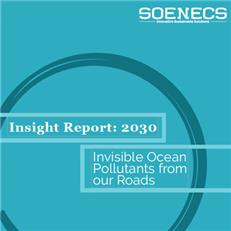Sponsored report | SUEZ 2030 Futures Insight Report: Invisible ocean...

SUEZ recycling and recovery UK (SUEZ) has today (06 April 2021) launched The Insight Report: 2030, Invisible Ocean Pollutants from our Road, in partnership with report authors SOENECS, Social, Environmental & Economics Solutions Ltd. The report reveals the potential scale of Tyre Wear Particles on UK roads and within ocean microplastics globally, and it sets out recommendations on how to address the challenge by 2030.
Key highlights of The Insight Report: 2030 include:
John Scanlon, Chief Executive Officer for SUEZ recycling and recovery UK said: "Understanding how tyre wear particles contribute to microplastics in our built environment is the first step in the journey to reducing microplastics in our natural environment and the global food chain. Meeting the challenge of reducing tyre wear particles is the next piece in the microplastic pollution puzzle.
"Constructive change is already underway to address those other better known sources of microplastics, which gives us all confidence for tackling microplastics from tyre wear particles by 2030. Extended producer responsibility schemes, deposit return systems, and other imminent policy changes will transform our usage of plastic bottles, while a ban of the use of microbeads in cosmetics has been introduced, and cross sector collaboration is underway to reduce plastic microfibre shedding from synthetic clothing. The road we must all drive along for the next decade to meet our 2050 carbon neutral target must be one that at the same time reduces ocean microplastic pollution, rather than increasing it with every press on the car brakes - the cause of this invisible pollutant."
The current design of electric vehicles can increase tyre wear and all cars currently rely on largely unchanged plastic composite rubber tyres, resulting in increased tyre dust pollution and ultimately higher levels globally of ocean microplastics. The Insight Report: 2030 identifies the five core factors that determine how we may be able to mitigate our invisible pollution problem of the present, as being: the design of tyres, cars, roads and their water management, driving skills and training; and the ability to improve interception of tyre wear particles at source.
In order to reduce overall tonnages of tyre wear particles and proportions that result in microplastics entering the ocean, SUEZ and SOENECS recommend wholescale changes by 2030 which will involve:
Dr David Greenfield, Managing Director of SOENECS Ltd, said: "Road vehicle designs of today must be fit for an electrified road network of tomorrow that can wean us off fossil fuels but will have also reduced microplastics from tyre dust. To engineer change and reduce microplastics pollution from tyres we can’t simply rely on changes to individuals’ driving habits, we must collaborate across the value chain of production and consumption in tandem with policy makers and technology innovators, all with end of life in mind to create a truly circular economy."
